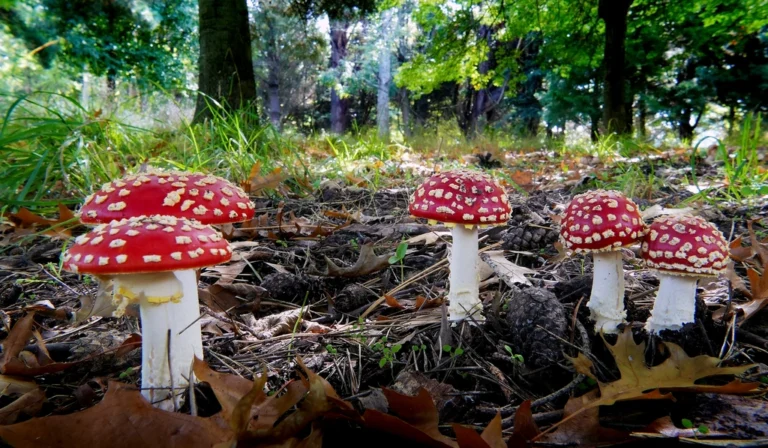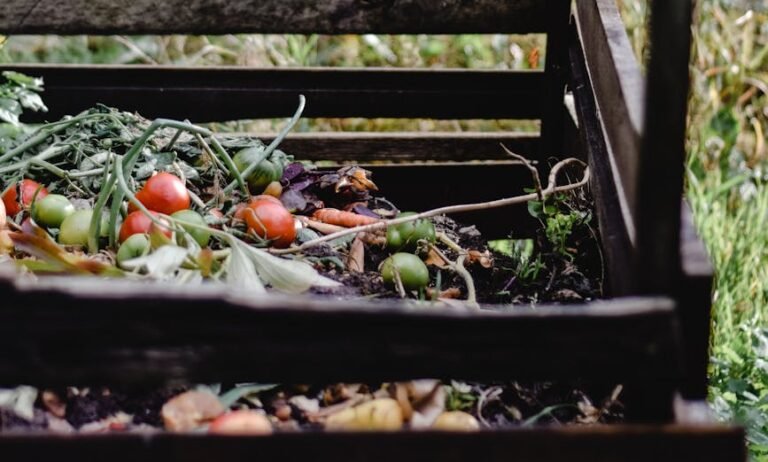

Introduction to Nettle and Comfrey
Nettle (Urtica dioica) and comfrey (Symphytum officinale) are two perennial plants that have garnered attention in gardening and composting contexts due to their unique properties and benefits. Both species thrive in a variety of conditions and are well-known for their remarkable nutrient profiles, making them valuable additions to compost piles.
Nettle is characterized by its serrated, heart-shaped leaves and can grow up to six feet tall, often found in moist, nutrient-rich soils. Although its stinging hairs can deter casual handling, nettle is laden with essential nutrients such as nitrogen, potassium, and calcium. These components are vital for plant growth, enhancing the nutrient content of compost when added. As such, nettle not only enriches compost but can also serve as a natural fertilizer when steeped in water to create a nutrient-dense liquid fertilizer.
Comfrey, on the other hand, is distinguished by its broad leaves and clusters of bell-shaped flowers, typically blue or purple. This hardy plant is known for its deep root system, which allows it to access minerals from the soil that many shallow-rooted plants cannot reach. Additionally, comfrey is rich in nutrients like nitrogen, phosphorus, and potassium, making it an excellent source of organic material for composting. The rotting leaves and stems can rapidly decompose to form a dark, nutrient-rich substance that enhances soil fertility.
Both nettle and comfrey are valued not just for their nutrient content but also for their ability to improve soil structure and encourage microbial life. This strategy of using natural plants in composting aligns well with sustainable gardening practices, promoting soil health and reducing the need for synthetic fertilizers. By utilizing nettle and comfrey in compost heaps, gardeners can harness nature’s power to create a more robust and productive growing environment.

Nettle: The Nutrient Powerhouse
Nettle (Urtica dioica) has long been recognized not only for its culinary and medicinal properties but also for its remarkable contributions to composting. As a nutrient powerhouse, nettle is rich in essential compounds that can significantly enhance the quality of compost. Key nutrients found in nettle include nitrogen, iron, and various vitamins, making it an excellent addition for gardeners and farmers alike.
The high nitrogen content of nettle is particularly beneficial for composting, as nitrogen is a crucial element for the decomposition process. It helps to facilitate microbial activity, which is vital for breaking down organic matter. This increased microbial activity leads to a more efficient composting process, producing nutrient-dense compost that can improve soil structure and fertility. Furthermore, the presence of nitrogen aids in promoting healthy plant growth, making nettle an invaluable resource in organic farming and gardening.
In addition to nitrogen, nettle is rich in iron, an essential micronutrient for plants. Iron plays a critical role in various physiological functions, including chlorophyll synthesis and enzyme activity. By incorporating nettle into compost, gardeners can ensure that their soil is well-equipped to support robust plant growth. Additionally, nettle contains an array of vitamins, particularly A, C, and K, which contribute to overall plant health and resilience against pests and diseases.
The historical uses of nettle extend beyond its role in gardening; it has also been employed in traditional medicine for centuries. Various cultures have utilized nettle for its reputed anti-inflammatory and diuretic properties. Today, its applications in agriculture are increasingly recognized, as it has the potential to improve soil health and support sustainable farming practices. By harnessing the power of nettle in compost, gardeners can not only enrich their soil but also embrace a time-honored approach to nurturing their plants.

Comfrey: The Soil Enhancer
Comfrey, a robust perennial herb, is widely recognized for its impressive nutrient profile, making it a valuable addition to any compost pile. This herb is particularly rich in potassium, calcium, and phosphorus, three essential macronutrients that play critical roles in plant health and growth. Potassium is pivotal for regulating various processes within plants, including water uptake and photosynthesis, while calcium contributes to cell wall structure and nutrient transport. Phosphorus, on the other hand, is vital for energy transfer and root development, promoting robust growth and flowering in various plant species.
The incorporation of comfrey into your compost not only elevates the nutrient content of the resulting compost but also enhances its overall quality. When added to the compost pile, comfrey leaves decompose rapidly, releasing their nutrients back into the mixture. This rapid breakdown means that gardeners can benefit from high-quality, nutrient-dense compost in a shorter time frame. Furthermore, the nutrients provided by comfrey contribute to compost’s ability to support healthy soil structure, allowing for improved aeration and drainage, which are essential for healthy root systems.
Comfrey’s role as a dynamic accumulator is of particular interest to gardeners and farmers alike. The plant’s deep taproot allows it to access nutrients and minerals from the soil that are typically out of reach for other plants. As the comfrey leaves decompose, they bring these concentrated nutrients back to the surface, enriching the compost and, subsequently, the soil where the compost is applied. This unique ability not only enhances soil fertility but also promotes moisture retention, reducing the need for frequent watering and contributing to more resilient ecosystems. By integrating comfrey into composting practices, gardeners can actively improve soil quality and promote sustainable gardening methods.

Benefits of Composting with Nettle and Comfrey
Adding nettle and comfrey to your compost pile brings numerous advantages that can significantly enhance the composting process. Both of these plants are recognized for their high nutrient content and their ability to promote microbial activity, making them invaluable additions to any compost mix. One of the primary benefits of using nettle is its high nitrogen content, which is essential for accelerating the decomposition of organic materials. Nitrogen-rich materials help microorganisms thrive, thereby speeding up the composting process and resulting in a more efficient breakdown of kitchen scraps and yard waste.
Comfrey, on the other hand, is notable for its unique ability to accumulate nutrients from the soil, particularly potassium, phosphorus, and calcium. When added to compost, comfrey contributes to a more balanced nutrient profile. This is particularly advantageous for producing compost that supports healthy plant growth, as it ensures that essential minerals are readily available. Furthermore, the inclusion of these plants fosters an environment rich in microbial diversity, which is crucial for the effective decomposition of organic matter.
The combination of nettle and comfrey can transform a standard compost pile into a nutrient-dense resource, ultimately leading to better-quality compost. The final product will not only break down faster but will also be richer in vitamins and minerals. This enhances its efficacy as a soil amendment, enabling gardeners to provide their plants with the necessary nutrients for optimal growth. In turn, this can lead to healthier crops and improved yields, solidifying the importance of incorporating these potent plants into composting practices.


How to Prepare Nettle and Comfrey for Composting
Adding nettle and comfrey to your compost pile can significantly enhance its nutrient content, but proper preparation is essential for maximizing their benefits. First, harvesting these plants at the right time is crucial. For nettle, the ideal moment is in spring when the leaves are young and tender, typically before they flower. Comfrey can be harvested at various times throughout the growing season, but late spring to early summer is optimal for ensuring high nutrient levels.
Once harvested, it is important to handle nettle with care, as it can cause skin irritation due to its stinging hairs. Wearing gloves during the harvesting process is advisable. After gathering, the plants should be cut down to manageable sizes. For effective composting, aim for pieces about 2 to 4 inches long. This size facilitates quicker decomposition and allows for optimal layering within the compost pile.
Layering techniques significantly influence the efficiency of your composting process. When adding nettle and comfrey, it is ideal to arrange them in layers rather than mixing them indiscriminately. Begin with a layer of coarse materials, such as small sticks, straw or wood chips, to promote good aeration. Next, add a layer of nettles followed by a layer of comfrey. Continue alternating these plants with other organic materials, ensuring that you balance green (nitrogen-rich) and brown (carbon-rich) materials. This balance is crucial for achieving a well-functioning compost pile.
As you build your compost, regularly monitor moisture levels. If the pile becomes too dry, add some water to maintain an ideal dampness. With these preparations, nettle and comfrey will decompose effectively, enriching your compost and enhancing the health of your garden.

Compost Ratios and Layering Techniques
Achieving an effective compost pile requires a thoughtful approach to the ratios of materials used, particularly when adding nitrogen-rich plants like nettle and comfrey. The ideal composting mix typically consists of a balanced ratio of greens (nitrogen sources) and browns (carbon sources). A common recommendation is to follow the 3:1 rule, which suggests combining three parts browns for every part of greens. Given that both nettle and comfrey are resourceful nitrogen contributors, it is imperative to monitor their incorporation to maintain this balance and optimize the composting process.
Nettle, known for its high nitrogen content, can promote microbial activity, while comfrey, another nutrient-dense plant, enhances the overall nutrient profile of the compost. When layering your compost, it is advantageous to create distinct layers, alternating between brown materials — such as dried leaves, straw, and shredded paper — and the nitrogen-rich greens such as nettle and comfrey. This layering technique not only improves aeration within the pile but also facilitates moisture retention, promoting decomposition. A well-structured pile allows for adequate airflow, which is essential for aerobic bacteria to thrive and accelerate the composting process.
In addition to proper ratios and layering, monitoring the moisture levels within the compost pile is crucial. Both nettle and comfrey can retain considerable water, so adding them in moderation and mixing them thoroughly with dry materials can prevent excessive moisture that could lead to anaerobic conditions. Regularly turning the compost pile aids in nutrient distribution and aerobic activity, further enhancing decomposition. By adhering to these recommended ratios and techniques, gardeners can create a nutrient-rich compost that harnesses the power of nettle and comfrey, ultimately benefiting their garden soil and plant health.

Common Mistakes to Avoid
When incorporating nettle and comfrey into your compost pile, it is crucial to be aware of common mistakes that can hinder the composting process and affect the final product. One of the primary pitfalls is adding an excessive amount of either plant. While both nettle and comfrey are nutrient-dense and can significantly enhance compost, an overload can imbalance the nitrogen-to-carbon ratio. This imbalance may lead to a slow breakdown of materials and a smelly, anaerobic environment, rather than the desired rich, earthy compost.
Another common error is using these plants in an inappropriate form. Nettle, for instance, is more beneficial when added as chopped greens rather than whole stems. Chopping increases the surface area exposed to microorganisms that aid decomposition. Similarly, when using comfrey, it is advisable to ensure that the leaves are wilted or dried before adding them to the compost pile. Fresh comfrey leaves can mat together, creating a barrier that prevents airflow and drainage, resulting in undesirable slime buildup that can attract pests.
Temperature control is also a vital factor to consider. The compost pile needs to reach adequate heat levels to break down organic material effectively. Adding nettle and comfrey late in the composting cycle, when temperatures are naturally cooler, can hinder the process. It is best to introduce these plants during the active composting phase to ensure they contribute effectively to the microbial activity.
Additionally, it is important to regularly turn the compost pile. Neglecting this task can lead to compacted layers that impede the aeration necessary for optimal decomposition. Proper mixing not only helps distribute the nutrients from nettle and comfrey but also promotes a healthy composting environment, reducing the risk of odors and maintaining optimal moisture levels. By avoiding these common mistakes, composters can fully harness the benefits of nettle and comfrey, creating a nourishing compost to enrich their gardens.


Using Finished Compost Enriched with Nettle and Comfrey
Utilizing finished compost enriched with nettle and comfrey can significantly enhance gardening and landscaping efforts. This nutrient-dense compost plays a crucial role in promoting healthy plant growth and ensuring robust yields. Nettle, rich in nitrogen, and comfrey, packed with potassium and phosphorus, contribute essential nutrients that cater to a wide variety of plants, making the compost a powerful ally in any gardener’s toolkit.
One of the primary benefits of incorporating this compost into your gardening practices is its ability to improve soil texture. The organic matter present in nettle and comfrey compost enhances soil structure by increasing aeration and water retention. This improved texture allows roots to penetrate more easily, facilitates drainage, and supports beneficial soil organisms, which are essential for a thriving ecosystem. As a result, plants cultivated in enriched compost typically exhibit vigorous growth and resilience to environmental stressors.
Moreover, using compost that features nettle and comfrey aligns with ecological gardening practices. The addition of these green ingredients promotes sustainability, reducing the need for synthetic fertilizers and chemicals. By employing natural amendments in your gardening efforts, you contribute to soil health and biodiversity. These practices foster a more sustainable environment, supporting essential pollinators and promoting microbial life in the soil.
When applied to gardens or landscapes, the nutrient-rich compost derived from nettle and comfrey can also improve the overall health of the plants. This compost not only provides essential nutrients but also enhances the soil’s capability to retain moisture, reducing the frequency of irrigation needed. Therefore, embracing compost enriched with nettle and comfrey becomes an invaluable strategy for those aiming to create eco-friendly and fruitful gardens.

Conclusion: Embracing Nature in Your Composting Journey
As we explore the numerous benefits of incorporating nettle and comfrey into compost piles, it becomes clear that these plants are invaluable allies for those seeking to enhance their composting practices. Nettle, known for its high nitrogen content, serves to invigorate the microbial life essential for decomposition, while comfrey’s remarkable potassium levels contribute to a nutrient-rich final product. These natural ingredients not only promote healthy soil but also lead to more robust plant growth when utilized effectively.
In practical terms, incorporating nettle and comfrey involves a few straightforward strategies. Nettle can often be found in abundance in wild areas or gardens, and comfrey can be cultivated easily, proving to be a hardy and beneficial addition. Furthermore, cutting these plants into smaller pieces before adding them to your compost is advisable, as this speeds up the decomposition process.
Moreover, experimentation plays a vital role in effectively harnessing the power of nettle and comfrey in your compost. Observing how these plants interact with other compost materials can lead to unique insights and the optimization of your compost mixture. Whether you are a seasoned composter or just starting, integrating these natural elements can provide a rewarding experience that enriches both your compost and your gardening endeavors.
By embracing nettle and comfrey in your composting methods, you contribute to developing healthier soil. As you embark on or continue your composting journey, remember that nature offers potent solutions. Harnessing its power can lead you to more sustainable gardening practices, ultimately benefiting your plants and the planet.




